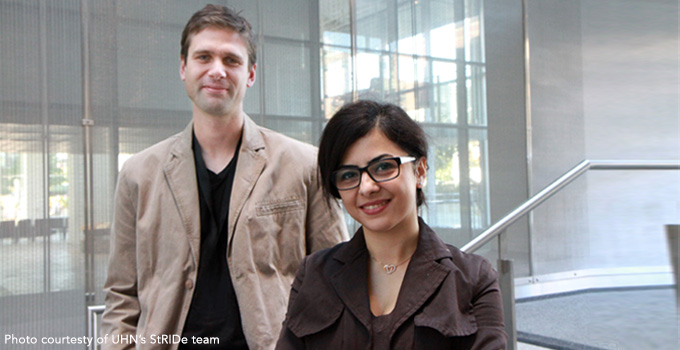
Biomarkers that can help predict a patient’s response to a given drug are central to testing new therapies in clinical trials as well as selecting which drugs to use in the clinic. Some of the biomarkers in use today rely on the overall expression of a given gene to predict if a drug will be of benefit. While these types of biomarkers have aided cancer research and treatment, a group led by Dr. Benjamin Haibe-Kains recently published research that is ushering in a new class of biomarkers – those based on gene isoforms (the different expression of the same gene within an individual). This work opens the door to more precise biomarkers.
Haibe-Kains is a Principal Investigator at the Princess Margaret Cancer Centre and an OICR Associate Researcher. His group’s recent research, published in Nature Communications, describes how they used RNA sequencing and multiple pharmacogenomic databases to identify a robust biomarker for four drugs for breast cancer: AZD6244, lapatinib, erlotinib and paclitaxel. This research was funded by the Canadian Breast Cancer Foundation-Stand Up to Cancer Canada Breast Cancer Dream Team initiative, which is partially funded by OICR.
“With the advent of RNA sequencing technology we can get a ‘high-resolution’ look at the different versions of a given gene,” explains Haibe-Kains. “Our research shows that these isoform expressions are more predictive of drug response than overall gene expression.”
The recent release of RNA sequencing profiles for more than 1,000 cell lines allowed the group to carry out this research. “We were able to analyze these cell lines against large databases to assess the association between gene isoforms and drug response in those cell lines,” says Haibe-Kains. “However, when you work with these large datasets they come with what we call ‘noise’, which can be best described as variations between different datasets as a result of differences in the way the data was generated. To get truly meaningful results we needed a solution to this issue.”
Zhaleh Safikhani, a Postdoctoral Research Fellow in Haibe-Kains’ lab and first author of the study, has been working on a fix to the issue of noisy datasets for a few years. “If you look at the drug-dose response curves for a given drug and cell line they should all be overlapping but there is variation due to the use of different experimental protocols,” she explains. “For a substantial proportion of cell lines you have discordant results. The way we dealt with that is by actually finding biomarkers that work across different datasets.”
The biomarkers discovered in the study were validated against three different pharmacogenomic datasets and the team used a unified computing pipeline to analyze the data across the datasets. “If you get good results using all the datasets then it is more likely that that biomarker will be validated in animal studies and further down the road in humans,” says Safikhani.
Much of this approach stems from a 2013 study by Haibe-Kains that shed light on the issues in using large pharmacogenomic datasets. He sees the group’s recent publication, and the methods therein, as an example of how further research using these databases can proceed with a high degree of confidence in results that will stand up to the test of reproducibility. “This paper shows that the scientific community now has the ability to find more accurate biomarkers that stand a better chance of successfully advancing through development and ultimately helping patients in the clinic through improved decision making about treatments,” says Haibe-Kains.
The data and software code used in the study have been made freely available online: https://github.com/bhklab/RNASeqDrug/
